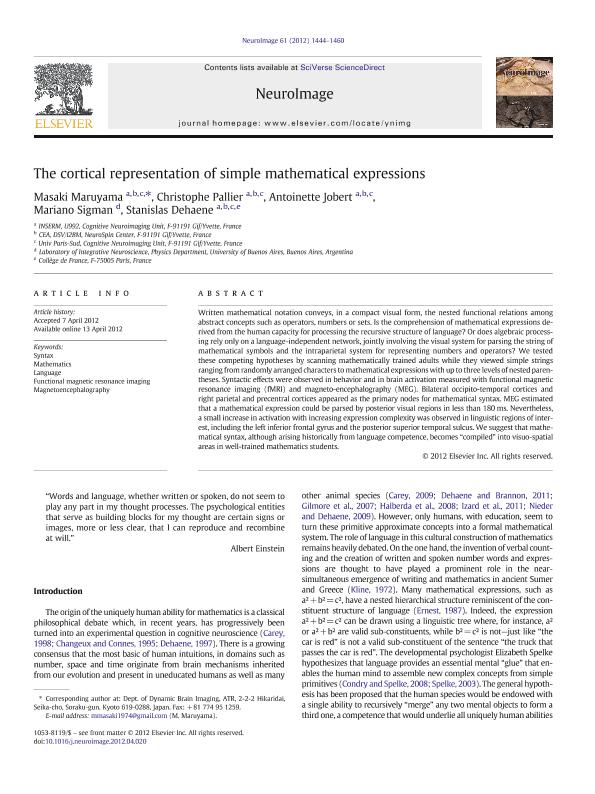Mostrar el registro sencillo del ítem
dc.contributor.author
Maruyama, Masaki
dc.contributor.author
Pallier, Christophe
dc.contributor.author
Jobert, Antoinette
dc.contributor.author
Sigman, Mariano

dc.contributor.author
Dehaene, Stanislas

dc.date.available
2019-06-13T16:00:13Z
dc.date.issued
2012-04
dc.identifier.citation
Maruyama, Masaki; Pallier, Christophe; Jobert, Antoinette; Sigman, Mariano; Dehaene, Stanislas; The cortical representation of simple mathematical expressions; Academic Press Inc Elsevier Science; Journal Neuroimag; 61; 4; 4-2012; 1444-1460
dc.identifier.issn
1053-8119
dc.identifier.uri
http://hdl.handle.net/11336/78208
dc.description.abstract
Written mathematical notation conveys, in a compact visual form, the nested functional relations among abstract concepts such as operators, numbers or sets. Is the comprehension of mathematical expressions derived from the human capacity for processing the recursive structure of language? Or does algebraic processing rely only on a language-independent network, jointly involving the visual system for parsing the string of mathematical symbols and the intraparietal system for representing numbers and operators? We tested these competing hypotheses by scanning mathematically trained adults while they viewed simple strings ranging from randomly arranged characters to mathematical expressions with up to three levels of nested parentheses. Syntactic effects were observed in behavior and in brain activation measured with functional magnetic resonance imaging (fMRI) and magneto-encephalography (MEG). Bilateral occipito-temporal cortices and right parietal and precentral cortices appeared as the primary nodes for mathematical syntax. MEG estimated that a mathematical expression could be parsed by posterior visual regions in less than 180. ms. Nevertheless, a small increase in activation with increasing expression complexity was observed in linguistic regions of interest, including the left inferior frontal gyrus and the posterior superior temporal sulcus. We suggest that mathematical syntax, although arising historically from language competence, becomes "compiled" into visuo-spatial areas in well-trained mathematics students. © 2012 Elsevier Inc.
dc.format
application/pdf
dc.language.iso
eng
dc.publisher
Academic Press Inc Elsevier Science

dc.rights
info:eu-repo/semantics/openAccess
dc.rights.uri
https://creativecommons.org/licenses/by-nc-nd/2.5/ar/
dc.subject
Functional Magnetic Resonance Imaging
dc.subject
Language
dc.subject
Magnetoencephalography
dc.subject
Mathematics
dc.subject
Syntax
dc.title
The cortical representation of simple mathematical expressions
dc.type
info:eu-repo/semantics/article
dc.type
info:ar-repo/semantics/artículo
dc.type
info:eu-repo/semantics/publishedVersion
dc.date.updated
2019-06-04T20:17:29Z
dc.journal.volume
61
dc.journal.number
4
dc.journal.pagination
1444-1460
dc.journal.pais
Países Bajos

dc.journal.ciudad
Amsterdam
dc.description.fil
Fil: Maruyama, Masaki. Inserm; Francia
dc.description.fil
Fil: Pallier, Christophe. Inserm; Francia
dc.description.fil
Fil: Jobert, Antoinette. Inserm; Francia
dc.description.fil
Fil: Sigman, Mariano. Universidad de Buenos Aires. Facultad de Ciencias Exactas y Naturales. Departamento de Física. Laboratorio de Neurociencia Integrativa; Argentina
dc.description.fil
Fil: Dehaene, Stanislas. Inserm; Francia
dc.journal.title
Journal Neuroimag

dc.relation.alternativeid
info:eu-repo/semantics/altIdentifier/doi/http://dx.doi.org/10.1016/j.neuroimage.2012.04.020
Archivos asociados
